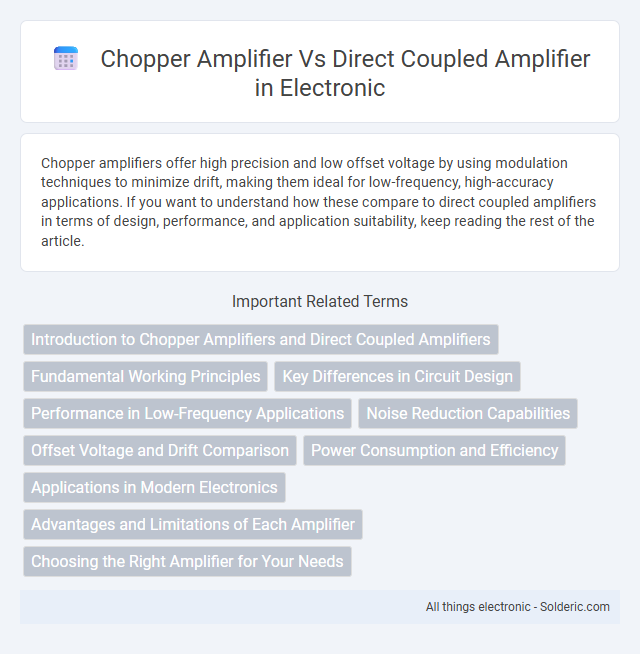Chopper amplifiers offer high precision and low offset voltage by using modulation techniques to minimize drift, making them ideal for low-frequency, high-accuracy applications. If you want to understand how these compare to direct coupled amplifiers in terms of design, performance, and application suitability, keep reading the rest of the article.
Comparison Table
| Feature | Chopper Amplifier | Direct Coupled Amplifier |
|---|---|---|
| Input Offset Voltage | Extremely low due to chopping technique | Higher offset voltage, affected by temperature |
| Noise Performance | Low flicker noise, improved low-frequency noise | Higher flicker noise and 1/f noise |
| Frequency Response | Limited bandwidth due to modulation/demodulation | Wide bandwidth, full frequency range |
| Complexity | More complex circuit design with switching elements | Simpler design, fewer components |
| Application | Precision DC amplification, sensor signal conditioning | General-purpose amplification, AC and DC signals |
| Power Consumption | Typically higher due to chopping frequencies | Lower power consumption |
| Output Drift | Minimal drift, enhanced stability | Prone to drift with temperature variations |
Introduction to Chopper Amplifiers and Direct Coupled Amplifiers
Chopper amplifiers utilize a modulation technique to reduce offset voltage and low-frequency noise, making them ideal for precision low-level signal amplification. Direct coupled amplifiers provide continuous signal transmission without capacitive or transformer coupling, enabling wide bandwidth and accurate low-frequency response. Understanding these fundamental differences helps you select the optimal amplifier type for applications requiring either ultra-low offset or seamless DC signal handling.
Fundamental Working Principles
Chopper amplifiers use a modulation technique where the input signal is periodically chopped and then amplified at a higher frequency to reduce low-frequency noise and offset errors. Direct coupled amplifiers amplify the input signal continuously without any interruption, relying on stable components to maintain low offset and drift. Your choice depends on whether you require ultra-low offset and noise reduction (chopper) or a simpler, continuous amplification process (direct coupled).
Key Differences in Circuit Design
Chopper amplifiers use a modulation-demodulation technique that converts low-frequency signals to a higher frequency to minimize offset voltage and low-frequency noise, whereas direct coupled amplifiers maintain a continuous DC path without any capacitive coupling. The chopper amplifier typically includes switches and a clock signal to periodically reset the input, improving precision in low-frequency applications, while direct coupled amplifiers rely on careful transistor matching and design to reduce offset. Your choice depends on whether you prioritize ultra-low offset voltage and low-frequency noise reduction (chopper) or simple design and wider bandwidth (direct coupled).
Performance in Low-Frequency Applications
Chopper amplifiers excel in low-frequency applications by minimizing input offset voltage and flicker noise, resulting in superior accuracy and stability compared to direct coupled amplifiers. Direct coupled amplifiers, while simpler, often suffer from increased offset drift and noise at low frequencies, affecting precision. For your sensitive low-frequency measurements, chopper amplifiers provide enhanced performance through dynamic offset cancellation and reduced low-frequency noise.
Noise Reduction Capabilities
Chopper amplifiers excel in noise reduction by minimizing low-frequency flicker noise through periodic modulation and demodulation, effectively shifting the signal away from noise-dominated frequencies. Direct coupled amplifiers, lacking this modulation technique, typically exhibit higher 1/f noise levels, making them less suitable for low-frequency applications requiring high signal integrity. The superior noise performance of chopper amplifiers makes them ideal for precision sensor signal conditioning and low-frequency analog circuitry.
Offset Voltage and Drift Comparison
Chopper amplifiers effectively cancel offset voltage and minimize drift by using periodic switching to modulate and demodulate input signals, achieving offset voltages in the microvolt range and near-zero drift over temperature. Direct coupled amplifiers, while offering wide bandwidth, inherently suffer from higher offset voltages typically in the millivolt range and exhibit significant drift due to temperature variations and input bias currents. Consequently, applications demanding ultra-low offset and minimal drift favor chopper amplifiers for enhanced precision and stability.
Power Consumption and Efficiency
Chopper amplifiers typically consume more power due to their switching operation and require additional circuitry for offset compensation, which can reduce overall efficiency compared to direct coupled amplifiers. Direct coupled amplifiers maintain continuous DC operation without switching losses, leading to lower power consumption and higher efficiency in applications requiring steady signal amplification. Your choice between the two should consider the balance between power efficiency and the need for offset correction in your specific application.
Applications in Modern Electronics
Chopper amplifiers excel in low-frequency, low-noise applications such as medical instrumentation and precision sensor signal conditioning, where minimizing offset and drift is critical. Direct coupled amplifiers are favored in applications requiring wide bandwidth and accurate DC amplification, including audio equipment and power supply monitoring. Your choice depends on whether the priority is stable DC performance or high-frequency response in modern electronic systems.
Advantages and Limitations of Each Amplifier
Chopper amplifiers offer high input impedance and low offset voltage, making them ideal for precision low-frequency signal amplification, but they may introduce ripple and require complex circuitry to minimize noise. Direct coupled amplifiers provide a wide bandwidth and fast response without frequency distortion, suitable for DC and low-frequency applications, although they often suffer from offset drift and thermal instability. Understanding your specific requirements helps determine whether the stability and precision of a chopper amplifier or the simplicity and speed of a direct coupled amplifier best suit your system.
Choosing the Right Amplifier for Your Needs
Choosing the right amplifier depends on the specific requirements of your application, with chopper amplifiers excelling in low-frequency and DC precision tasks due to their ability to minimize offset voltage and low-frequency noise. Direct coupled amplifiers offer a wider bandwidth and faster response, making them suitable for high-speed and AC signal amplification without distortion. Consider factors such as signal frequency, noise tolerance, and accuracy requirements to determine whether a chopper or direct coupled amplifier best fits your electronics design.
chopper amplifier vs direct coupled amplifier Infographic

 solderic.com
solderic.com